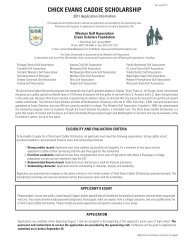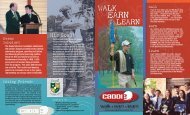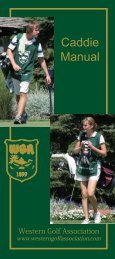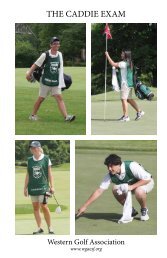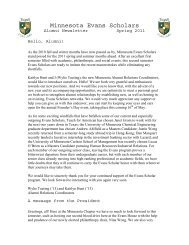WGA Caddie/Scholar Toolkit - Western Golf Association
WGA Caddie/Scholar Toolkit - Western Golf Association
WGA Caddie/Scholar Toolkit - Western Golf Association
Create successful ePaper yourself
Turn your PDF publications into a flip-book with our unique Google optimized e-Paper software.
<strong>WGA</strong> <strong>Caddie</strong>/<strong>Scholar</strong> Recruitment<br />
– <strong>Caddie</strong>s/<strong>Scholar</strong>s<br />
A Guide to <strong>Caddie</strong> Development/<strong>Scholar</strong> Recruitment at Your Club<br />
1
Your Role as a <strong>Western</strong> <strong>Golf</strong> <strong>Association</strong> Director<br />
As a <strong>WGA</strong> Director, you are the grassroots representative at your club in the <strong>Western</strong> <strong>Golf</strong><br />
<strong>Association</strong>’s ongoing campaign to recruit caddies with the potential to qualify for the Chick<br />
Evans <strong>Caddie</strong> <strong>Scholar</strong>ship.<br />
To assist you in executing your personal strategy for caddie recruitment/Evans <strong>Scholar</strong>s<br />
development at your club, the <strong>WGA</strong> <strong>Caddie</strong> Committee has compiled the following<br />
<strong>Caddie</strong>/<strong>Scholar</strong> <strong>Toolkit</strong>. With the <strong>WGA</strong>’s stated mission to increase the number of Evans<br />
<strong>Scholar</strong>ships awarded annually, it is imperative that we, as Directors, make a concerted effort<br />
to implement a strategy to recruit caddies who may eventually earn an Evans <strong>Scholar</strong>ship.<br />
Please accept the following “Best Practices” as a guide in developing your own, personalized<br />
approach to caddie recruitment/<strong>Scholar</strong> development at your club.<br />
We welcome your ideas and personal “Best Practices” for possible use in this evolving<br />
document. In the coming year, <strong>WGA</strong>/ESF Headquarters is planning an upgrade of the<br />
organization’s Web site that will allow us to post these items and items related to other<br />
Director functions on the host site for your availability to review, download and utilize at your<br />
convenience.<br />
Thank you for the work you do on behalf of the <strong>Western</strong> <strong>Golf</strong> <strong>Association</strong>/Evans <strong>Scholar</strong>s<br />
Foundation.<br />
<strong>Caddie</strong> Committee Chairman<br />
Joe Schmidt<br />
773.339.7026<br />
jschmidt@stpatrick.ord<br />
1
Document I – <strong>Caddie</strong> Development & Evans <strong>Scholar</strong> Recruitment<br />
Page 1 .....................................A Message from the <strong>Caddie</strong> Chairman<br />
Page 3-4 .................................<strong>WGA</strong> Director’s Responsibilities – General Overview<br />
Page 5 .....................................Introduction<br />
Page 6 .....................................Benefits of a <strong>Caddie</strong> Program<br />
Page 7 .....................................<strong>Caddie</strong> Program Guidelines<br />
Pages 7 ...................................Recruiting<br />
Pages 8 ................................... Training<br />
Page 9 .....................................Classifying<br />
Page 10 ...................................Assigning<br />
Page 11 ...................................Evaluating<br />
Pages 12 .................................Paying<br />
Page 13 ...................................Incentives & Awards<br />
Page 13 ...................................Publicizing the Evans <strong>Scholar</strong>ship<br />
Page 13-14 .............................Involvement with <strong>Caddie</strong> Manager<br />
Other available <strong>Toolkit</strong> documents:<br />
Document II – Promoting the Evans <strong>Scholar</strong>s in Club Newsletters, Local Media and In-Club<br />
Displays<br />
Supporting PDF documents available for e-mail:<br />
• <strong>WGA</strong> Par Club Application<br />
• <strong>WGA</strong> Yellow Facts Brochure<br />
• <strong>WGA</strong> ESF <strong>Scholar</strong>ship House Brochure<br />
• ESF Facts At-a-Glance<br />
• Sample Newsletter Articles/Inserts<br />
2
<strong>WGA</strong> Director Responsibilities<br />
The following is a sample of the types of involvement a director might employ at his or her club<br />
on behalf of the program. This list has been broken down to the three key areas of activity for<br />
the Directors:<br />
-Raising Funds for the Evans <strong>Scholar</strong>ship<br />
-Promoting <strong>Caddie</strong> Programs generally and at your Club<br />
-Raising Awareness of the Evans <strong>Scholar</strong>ship<br />
This list is intended to be exemplary and not all activities will be appropriate for or used by all<br />
Clubs. It is likely that highly developed Clubs will use many of these techniques. In addition, it<br />
is not intended to be “all inclusive” as many Directors have and are using other very effective<br />
techniques. Lastly, it might be wise to form a “committee” or otherwise dedicated group at the<br />
Club to help carry out the various activities on this list.<br />
I. Directors serve 3-year terms which are renewable after review<br />
II. Raising Funds for the Evans <strong>Scholar</strong>ship<br />
A. Raising New and upgrading existing Par Club memberships<br />
a. Monitoring annual appeal<br />
b. Drafting follow-up letters:<br />
1. New members<br />
2. Those who declined<br />
B. Identify donors that are capable of going “above and beyond” Par Club<br />
C. Implementing Bag Tag programs where appropriate<br />
III. Promoting <strong>Caddie</strong> Programs generally and at your Club<br />
D. Monitoring the caddie program<br />
a. Working with the pro and caddie master (invite them to selection meetings)<br />
b. Involving the caddie committee chairman<br />
1. Requested written report from caddie master<br />
2. Monitor the caddie training program<br />
3. Make sure they’re in contact with <strong>WGA</strong> <strong>Caddie</strong> Development Manager<br />
E. If needed:<br />
a. Prepare caddie master job description<br />
b. Help in search for new or replacement caddie master<br />
F. Recruitment of caddies<br />
a. Meeting with school superintendents<br />
b. Meeting with school counselors<br />
G. Promoting the caddie banquet<br />
3
IV. Raising Awareness of the Evans <strong>Scholar</strong>ship Program<br />
H. Involving Club’s board is critical<br />
a. Getting new board members to selection meetings<br />
b. Inviting all members to Evans events<br />
c. Saying “Thank You” to the Board annually<br />
I. Mentoring potential scholar candidates<br />
a. Assigning club members or Evans <strong>Scholar</strong>s to each candidate<br />
b. Meetings with caddies in caddie yard to explain the program<br />
J. Actively involving club members who are Evans <strong>Scholar</strong>s Alumni<br />
K. Preparing articles for the club newsletter<br />
L. Maintaining bulletin board of Evans <strong>Scholar</strong>s Alumni and Active <strong>Scholar</strong>s in the pro shop<br />
M. Introduce/Re-Introduce the <strong>Scholar</strong>ship at season opening events for both men and<br />
women<br />
N. Considering ways to thank membership for support<br />
a. Circulate letters from club caddies currently in school that highlight their<br />
accomplishments<br />
b. Run/organize club event (Example: 7 Club tournament)<br />
O. Organize Evans Alumni outing events (getting board approval)<br />
V. Other Opportunities for Involvement<br />
P. Make periodic visits to the <strong>Scholar</strong>ship House<br />
Q. Maintaining contact with staff at <strong>WGA</strong> to make sure you’re up to date with their and the<br />
directors initiatives.<br />
R. Volunteer at the <strong>WGA</strong>-run golf tournaments.<br />
S. Participate in State and/or National Committees<br />
Attend the Summer Outing<br />
4
Introduction<br />
The <strong>Western</strong> <strong>Golf</strong> <strong>Association</strong> provides affiliated clubs with extensive resources for the development<br />
and operation of caddie programs at the club level.<br />
Materials available include<br />
<strong>Caddie</strong> training video<br />
<strong>Caddie</strong> training manual<br />
<strong>Caddie</strong> exam<br />
<strong>Caddie</strong> operations manual<br />
Brochures and posters promoting the benefits of caddie programs<br />
The 41-minute caddie training video, titled “<strong>Caddie</strong> Orientation,” outlines caddie duties before, during,<br />
and after the loop. The video is ideal for the training of first-year caddies and is an excellent refresher<br />
for experienced caddies.<br />
The <strong>Western</strong> <strong>Golf</strong> <strong>Association</strong> recognizes the fact that many golf courses and clubs take alternative<br />
approaches to running a caddie program. The following Best Practices Manual should be used as<br />
guideline if a program is interested in exploring different options. We also understand that many<br />
variables effect caddie programs such as geographical location, number of golfers, number of caddies,<br />
etc. Therefore, we recommend these practices as general recommendations rather than a formula for<br />
success for all caddie programs.<br />
Some of the elements found in successful caddie programs are a dedicated caddie manager (caddie<br />
master), involved Professional Staff, and interested <strong>Golf</strong>ers. The caddie manager is responsible for<br />
recruiting, training, selecting, paying, promoting, encouraging and reprimanding the caddies<br />
appropriately. Another important role that the caddie manager plays is to make sure that the supply of<br />
caddies correlates with the demand. This means not taking on too many caddies as well as making sure<br />
to have an ample supply.<br />
The Professional Staff which includes the Head <strong>Golf</strong> Professional as well as his/her assistants need to be<br />
supportive of the program as well.<br />
The <strong>WGA</strong> employs a caddie services manager who assists club officials in creating and maintaining<br />
caddie programs through on-site reviews and consultations. Also, the caddie services manager<br />
promotes the use of caddies through various educational and informational programs and seminars.<br />
5
Benefits of a <strong>Caddie</strong> Program<br />
Caddying is as a much part of the game of golf as the ball or club. Andrew Dickson carried clubs for the<br />
Duke of York in a match play in 1682. Since then, many golfers, clubs, communities, and young people<br />
have experienced the great benefits of a caddie program.<br />
<strong>Golf</strong>er Benefits<br />
Improves the quality of your game – letting a caddie handle the details of clubs, flagstick, divots,<br />
and bunkers allows the golfer to focus and improve your game.<br />
Increases the health benefits – walking is an appetite suppressant, muscle relaxant, stress<br />
reliever, cardiovascular toner, weight reducer, and more.<br />
Increases personal satisfaction – by utilizing a caddie, you immediately put yourself in a position<br />
to strongly impact the life of a young person by taking on a mentoring role.<br />
Amplifies the golfing experience – having a caddie will enlighten your golfing experience<br />
especially when you are bringing guests.<br />
Club Benefits<br />
Speeds up pace of play – the fastest way to play is with a caddie. Always someone to clean up<br />
after you on the tees, fairways, bunkers, and greens frees the golfer to move along and play<br />
quicker.<br />
Enhances the status and image of the club – by offering a caddie to the patrons of a club you<br />
immediately increase the prestige of that club.<br />
Improves course conditions – there will be an increase in the overall maintenance of the course<br />
due to caddies fixing divots, ball marks, and bunkers.<br />
<strong>Caddie</strong> Benefits<br />
Opportunity to earn good money during flexible hours – many young people today have<br />
numerous extracurricular activities. Caddying gives many young people a chance to continue<br />
those activities while making money.<br />
Exposure to positive role models – young people will have the chance to learn from mature and<br />
successful individuals.<br />
Opportunity to have a great work environment – caddies have the ability to work outside and to<br />
interact with their peers, giving them a means to make friends while working.<br />
Ability to work and exercise – the same health benefits for golfers apply for young people.<br />
Opportunity to be awarded a Chick Evans <strong>Caddie</strong> <strong>Scholar</strong>ship – currently, more than 840 caddies<br />
are attending one of 19 universities on a Chick Evans <strong>Caddie</strong> <strong>Scholar</strong>ship. The scholarship covers<br />
full tuition and housing costs for up to four years of college.<br />
Community Benefits<br />
Our young caddies develop outstanding work ethic and attitude – caddying is often the first job<br />
for many young people. Caddying exposes them to a real life work experience.<br />
<strong>Caddie</strong>s often take on other roles at the club including bag room and bag drop attendants, valet<br />
staff, etc…<br />
A mentoring relationship is developed in a healthy environment.<br />
A caddie program offers a chance for the club to give something back to the community.<br />
In recognition to these benefits and the importance of caddie programs, the <strong>Western</strong> <strong>Golf</strong> <strong>Association</strong><br />
encourages golfers to use caddies whenever they are available. The <strong>WGA</strong> also encourages the use of a<br />
forecaddie when golfers elect to ride.<br />
6
<strong>Caddie</strong> Program Guidelines<br />
The <strong>WGA</strong> believes there is no one correct caddie program formula that is all encompassing. A common<br />
formula for successful caddie programs include well-trained caddies, an intuitive caddie manager,<br />
proactive head golf professional and staff, active caddie chairperson, and influential <strong>WGA</strong> Director.<br />
Recruiting<br />
It is important to determine a reasonable desired number of caddies that you need prior to recruiting<br />
new caddies. By establishing the correct number of caddies on your roster, a caddie manager can<br />
eliminate the turnover and maintain a group of quality caddies. You can eliminate many problems by<br />
understanding the demands of your caddies and golfers. Accepting too many caddies will result in high<br />
turnover and low standards. Turning away too many caddies will result in disappointed golfers.<br />
Many caddie programs have no need for recruiting because their word-of-mouth promotion provides<br />
ample new caddies every year. However, there are some techniques to recruit the right individuals.<br />
Contact local schools in order to promote caddying at your club. Contact the guidance counselors in<br />
order to identify qualified applicants that excel academically, come from modest financial background,<br />
and are of outstanding character. Also, there are caddie programs that require caddie applicants to<br />
bring in a copy of their report card to apply. This allows the caddie manager to identify the students<br />
that qualify academically for the Evans <strong>Scholar</strong>ship.<br />
Many caddie programs have elected to work with non-profit organizations that benefit young people.<br />
By associating with organizations such as the Daniel Murphy <strong>Scholar</strong>ship Fund, programs can increase<br />
the number of qualified caddie and Evans <strong>Scholar</strong> applicants.<br />
It is important to involve the parents of the caddies in the process. Parents should be made aware of<br />
what is expected of both them and their child. A caddie parent meeting should be held in the beginning<br />
of the spring in order to answer any questions the caddies or their parents might have. Also, this serves<br />
as a great time to communicate the rules of the caddie program. This allows the parents to have a level<br />
of buy-in to the program and will increase the chances of success.<br />
7
Training<br />
In order for the caddie program to add value to any club/course, the caddies in the program need to be<br />
well-trained. Each caddie applicant should be well-acquainted with the <strong>WGA</strong> issued <strong>Caddie</strong> Training<br />
Manual, <strong>Caddie</strong> Orientation Video, and have successfully completed the <strong>WGA</strong> issued <strong>Caddie</strong> Exam. The<br />
<strong>Caddie</strong> Training Manual should be well read prior to the first training session. The <strong>WGA</strong> promotes both<br />
classroom style and on-the-course training.<br />
The caddie manager should head the training with the assistance from the course professionals,<br />
members/golfers, and experienced caddies. Some caddie programs require 2 days of caddie training,<br />
while others require a week or more. Many caddie managers teach in a classroom style atmosphere for<br />
the first day of training. The reason behind this is because many of the applicants may not have any<br />
experience with golf or a golf course. Pre-training is vital in order for on-course-training to be effective.<br />
<strong>Caddie</strong> managers may take large groups onto the course at one time, while others will assign one caddie<br />
trainee per one caddie trainer. Once again, the caddie trainers are usually golfers who often take<br />
caddies, professional staff of the course, or the most experienced caddies. The desired approach is to<br />
have one trainer per trainee.<br />
It is the belief of the <strong>WGA</strong> that training should be thorough and continuous. Immediate feedback<br />
should be given to caddies in order to assist them serve the club and its golfers. Training continues well<br />
after an applicant becomes a certified caddie. Most caddie programs have pay tickets that are equipped<br />
with a caddie evaluation section. Considerable thought should be given in completing the evaluation<br />
sheet prior to turning it into the caddie manager. Once the caddie manager has the evaluation it is<br />
his/her job to take corrective action to remedy any issues the caddie is having.<br />
If you are interested in participating in the training of caddies, please contact the caddie manager and<br />
offer your assistance. The top caddie programs in the country have active member/golfer participation.<br />
8
Classifying<br />
<strong>Caddie</strong>s are often classified by different ranked based upon their experience and abilities. Most often,<br />
first year caddies are referred to as “B” caddies. These first-year caddies often need guidance and<br />
patience. Ideally, the caddie manager will pair first-year caddies with a more experienced caddie in<br />
order to assist in further training as well as keep up with the pace of play. “B” caddies should be<br />
expected to be able to perform the following duties:<br />
<br />
<br />
<br />
<br />
<br />
<br />
<br />
<br />
calculate yardage<br />
maintain pace of play by staying in front of golfer<br />
and locating ball<br />
replace divots<br />
rake bunkers<br />
forecaddy on appropriate holes<br />
stand quietly and politely during play<br />
keep golf clubs clean<br />
keep golf balls clean<br />
<br />
<br />
<br />
<br />
<br />
<br />
<br />
possess a general understanding of the rules of<br />
golf<br />
illustrate courtesy before, during, and after<br />
round<br />
assist with the general upkeep of the course<br />
follow specific instructions<br />
show attentiveness and a good attitude<br />
demonstrate hustle and a determined work ethic<br />
exhibit ability to work as a team with other<br />
caddies<br />
More experienced caddies are often promoted from “B” to “A”. The main motivation for this often<br />
times is the increase in base pay due to their increase in experience and ability. “A” caddies should be<br />
expected to be able to perform more duties at a higher standard. Their duties include all of the<br />
previously stated in addition to:<br />
<br />
<br />
<br />
<br />
<br />
<br />
<br />
<br />
offer course and local knowledge<br />
provide direction and effect of the wind<br />
calculate yardage to bunkers and hazards<br />
provide service to multiple golfers<br />
possess a more advanced knowledge of the game of golf<br />
encourage and train inexperienced caddies<br />
act as role models in the caddie yard/house<br />
exhibit confidence and leadership<br />
Once an “A” caddie has illustrated their mastering of their duties, they should be promoted to the<br />
“Honor” level. “Honor” caddies will be able to perform the above duties the most exceptional standard<br />
as well as the following:<br />
<br />
<br />
<br />
<br />
provide expert advice regarding course layout and conditions<br />
assist caddie manager with everyday operations<br />
offer assistance during training sessions<br />
mentor both “A” and “B” caddies to become better<br />
Please note that beginner caddies should be evaluated on their effort and attitude while more advanced<br />
caddies should be evaluated on their performance. Patience is needed with beginner caddies. Please<br />
provide caddies with immediate feedback as well as your reasoning behind your opinion regarding a<br />
situation. Accurate evaluations of caddies via the caddie ticket/chit sheet will only improve the overall<br />
quality of the program. Please be honest and fair during your evaluations.<br />
9
Assigning<br />
Every caddie program assigns caddies to golfers differently. Some caddie managers take a scientific<br />
approach to the assigning of “loops” while others view it as an art form.<br />
Certain clubs implement a roll call system. <strong>Caddie</strong>s are to arrive by a certain time, prior to the roll call.<br />
<strong>Caddie</strong>s’ are categorized by rank (i.e. Honor, “A”, & “B”). The order in which your name or number are<br />
drawn is the order in which each caddie will be assigned. It is important to separate the classes of<br />
caddies in order to avoid 4 “B” caddies in the same group.<br />
The scientific option is a hierarchal approach. Once a golfer has determined they are going to golf, the<br />
caddie manager will offer it to the Honor <strong>Caddie</strong>s. The highest Honor <strong>Caddie</strong> has his/her choice to<br />
accept that golfer or pass it to the second ranking Honor <strong>Caddie</strong>. This process continues down to the<br />
“A” and “B” <strong>Caddie</strong>s.<br />
One alternative requires more consideration from the caddie manager. To assign a caddie the caddie<br />
manager takes several variables into consideration in order to determine the best caddie for the golfer.<br />
Elements to factor into the decision are personality of both the golfer and caddie, quality of caddie and<br />
the typical payment from the golfer, and the desired level of caddie from the golfer. Sometimes a golfer<br />
who usually takes an experienced caddie will ask for a new caddie to assist in the training and<br />
development of the new caddie. Several country clubs utilize this method. In all circumstances, fairness<br />
is the caddie manager’s underlying goal. Every effort is made to place at least two “A” and/or Honor<br />
caddies in each group.<br />
Lastly, some caddie programs have their caddies email/call the caddie manager to inform him/her of<br />
their availability for the week. Once a golfer calls to make a tee time the caddie manager can cross<br />
reference the available caddies in order to assign that loop. This process is only applicable to courses<br />
that require tee times. This is a useful method for caddies programs that lack a place for caddies to<br />
congregate prior to their loops. If a caddie is scheduled to tee off at 8:00am, they have the ability to<br />
arrive shortly before their tee time without waiting several hours.<br />
If a caddie comes to the course and does not caddie on a given day, the individual’s name should be<br />
placed on the top of the list for the following day regardless of which method is employed.<br />
10
Evaluating<br />
Serious thought and consideration should be placed on the evaluation of a caddie throughout the round.<br />
Feedback should be given in order to better the individual. It is vital that the caddie evaluation card is<br />
completed at the conclusion of the round. Honest and fair grading of the individual caddie will better<br />
both the individual and the caddie program as a whole. It is the responsibility of the caddie manager to<br />
reprimand caddies for their actions once they arrive at the course. Therefore, if a situation arises please<br />
make it known to the caddie manager and he/she will take necessary action.<br />
<br />
11
Paying<br />
Standard caddie rates should be made public to all members/golfers. Many programs will offer several<br />
rates. Some of the variables to consider when paying a caddie include the rank of the caddie as well as<br />
the service provided. The higher the ranking of the caddie means a higher pay scale. Also, the per-bagrate<br />
for walking caddies is higher than a per-bag-rate for forecaddies. Rates vary from program to<br />
program. Please review a grid that assist in the payment of caddies.<br />
It should be stated that new caddies should be compensated for attitude and effort, while experienced<br />
caddies should be based on attitude, effort and performance.<br />
<br />
12
Incentives & Awards<br />
Many caddie programs award the hard work of their top caddies by honoring them at an end of year<br />
banquet. The meal is donated by the members of the club. Often times the members also contribute<br />
either money and/or gifts for the top caddies. The caddies have their choice of a selection of prizes.<br />
Many caddie programs award the <strong>Caddie</strong> of the Year and “Rookie” <strong>Caddie</strong> of the Year.<br />
Certain clubs have a <strong>Caddie</strong>/Member <strong>Golf</strong> tournament. The caddies are encouraged to play in the event<br />
and members are asked to participate in various ways. Some members will assist as starters or<br />
marshals. Certain clubs have their members caddy for the caddies. This provides a unique perspective<br />
for both golfers and caddies to spend a day on the “other side of the bag.” In addition to golf, the pool,<br />
tennis courts, and other facilities of the club are available to the non-golfing caddies to enjoy.<br />
Publicizing the Evans <strong>Scholar</strong>ship<br />
A great way to publicize the Evans <strong>Scholar</strong>ship Foundation is to highlight your current Evans <strong>Scholar</strong>s.<br />
Identify current <strong>Scholar</strong>s with a special caddie bib, shirt, or hat, complete with their name and the<br />
university he/she attends. This will often generate questions from younger caddies or individuals who<br />
are unfamiliar with the program.<br />
Many clubs have an Evans <strong>Scholar</strong>s display to showcase their past and current Evans <strong>Scholar</strong>s. Certain<br />
clubs will have an 8”x10” picture of the current <strong>Scholar</strong>s to enhance their display. There are a variety of<br />
areas to place an Evans <strong>Scholar</strong>s display. Some examples include in the pro shop, clubhouse, locker<br />
rooms, and bag drop. Any area there is high traffic is ideal for such a display.<br />
Involvement with <strong>Caddie</strong> Manager<br />
The caddie manager plays a crucial role in the success of a caddie program. It is important to outline the<br />
necessary activities for the caddie manager prior to the start of each caddie season. One way to<br />
establish the goals for a caddie manager is to assist in the preparation of the job description. An<br />
evaluation should take place before and after each caddie season to assess the goals and achievements<br />
of the caddie manager as well as the caddie program. Below is an example of a caddie manager job<br />
description.<br />
13
<strong>Caddie</strong> Master Job Description<br />
The <strong>Caddie</strong> Master’s primary responsibility is the recruitment, training and supervision of<br />
caddies who work at the club. The <strong>Caddie</strong> Master is an employee of the Club, but must have a<br />
close working relationship with the <strong>Golf</strong> Professional and his staff. The individual in this<br />
position will also work closely with a member of the Board of Governors who has responsibility<br />
for the caddie program.<br />
The <strong>Caddie</strong> Master’s job begins on April 1 and runs through October 31. The <strong>Caddie</strong> Master’s<br />
work day begins at approximately 7:00 a.m. and ends at 3:00 p.m. unless special circumstances<br />
(agreed to beforehand) require a modification of the hours on a given day. The Club is open<br />
Tuesday through Sunday, but special events occasionally require work on Mondays. (Days off<br />
are coordinated with the <strong>Golf</strong> Pro Shop and Club Manager).<br />
Benefits include Medical Insurance, a discretionary Christmas Bonus and eligibility to<br />
participate in I.R.A contribution plan.<br />
Primary responsibilities include:<br />
1. Train new caddies as to the rules of golf and the duties to be performed while on the golf<br />
course. In doing so, on course training sessions can be supplemented with printed<br />
materials and videotapes made available by the <strong>Western</strong> <strong>Golf</strong> <strong>Association</strong>.<br />
2. Make sure that caddies are available to all golfers, giving equal opportunity to all caddies.<br />
Issues that are taken into consideration are the time of arrival of a caddie on a given day,<br />
their regularity in reporting to work, and their seniority in the caddie program.<br />
3. Work with the <strong>Golf</strong> Professional and Club Manager to determine the number of caddies<br />
needed for special high demand events, (i.e. Club tournaments and Monday golf outings<br />
for outside groups)<br />
4. Evaluate caddie performance aided by members’ comments and printed caddie<br />
evaluations.<br />
5. Promote caddies to a higher pay grade when appropriate.<br />
6. Handle and issue payouts to the caddies. Balance cash box each week with the Club’s<br />
Accountant.<br />
7. Maintain <strong>Caddie</strong> Master’s office and see that caddie rest areas and yard are kept clean at<br />
all times.<br />
8. Communicate with the Club Manager if any caddie related equipment or building aria is<br />
in need of repair.<br />
9. Supervise the caddie bonus system, golf tournament and yearly banquet.<br />
10. Keep all caddies informed about opportunities available to them through the Evans<br />
<strong>Scholar</strong>ship program. (Note: Language can be strengthened to include recruiting,<br />
training, informing and nurturing Evans <strong>Scholar</strong> type caddies.)<br />
At the beginning of the season, and also at the end, golf activity may be slow. During these<br />
times the <strong>Caddie</strong> Master may be asked to with the Club Manager on special projects.<br />
Conversely, when use of golf course is at its greatest and the work of the Pro Shop is intense, the<br />
<strong>Caddie</strong> Master may be asked to assist the staff members in locating their golf clubs, issuing golf<br />
carts or responding to other member requests.<br />
14



